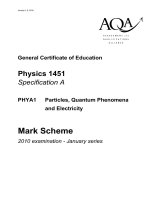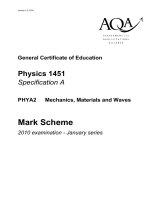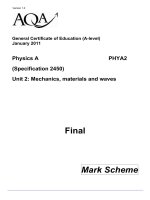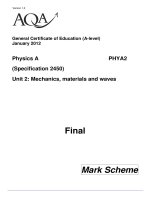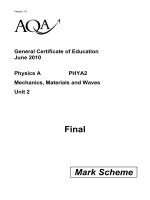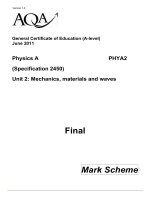AQA ANTH2 w MS JAN13
Bạn đang xem bản rút gọn của tài liệu. Xem và tải ngay bản đầy đủ của tài liệu tại đây (235.36 KB, 16 trang )
Version 2.0
General Certificate of Education
January 2013
1111
Anthropology
ANTH2
Becoming a Person:
Processes, Practices and
Consequences
Unit 2
Final
Mark Scheme
Mark schemes are prepared by the Principal Examiner and considered, together with the
relevant questions, by a panel of subject teachers. This mark scheme includes any
amendments made at the standardisation meeting attended by all examiners and is the scheme
which was used by them in this examination. The standardisation meeting ensures that the
mark scheme covers the students’ responses to questions and that every examiner
understands and applies it in the same correct way. As preparation for the standardisation
meeting each examiner analyses a number of students’ scripts: alternative answers not already
covered by the mark scheme are discussed at the meeting and legislated for. If, after this
meeting, examiners encounter unusual answers which have not been discussed at the meeting
they are required to refer these to the Principal Examiner.
It must be stressed that a mark scheme is a working document, in many cases further
developed and expanded on the basis of students’ reactions to a particular paper. Assumptions
about future mark schemes on the basis of one year’s document should be avoided; whilst the
guiding principles of assessment remain constant, details will change, depending on the content
of a particular examination paper.
Further copies of this Mark Scheme are available to download from the AQA Website: www.aqa.org.uk
Copyright © 2013 AQA and its licensors. All rights reserved.
COPYRIGHT
AQA retains the copyright on all its publications. However, registered centres for AQA are permitted to copy material
from this booklet for their own internal use, with the following important exception: AQA cannot give permission to
centres to photocopy any material that is acknowledged to a third party even for internal use within the centre.
Set and published by the Assessment and Qualifications Alliance.
The Assessment and Qualifications Alliance (AQA) is a company limited by guarantee registered in England and Wales (company number 3644723) and a registered charity (re gistered charity number 1073334).
Registered address: AQA, Devas Street, Manchester M15 6EX
Anthropology ANTH2 - AQA GCE Mark Scheme January 2013
QUALITY OF WRITTEN COMMUNICATION
Where students are required to produce extended written material in English, the scheme of
assessment must make specific reference to the assessment of the quality of written
communication. Students must be required to:
ensure text is legible, and spelling, grammar and punctuation are accurate, so that meaning
is clear
select and use a form and style of writing appropriate to purpose and complex subject
matter
organise relevant information clearly and coherently, using specialist vocabulary when
appropriate.
The assessment criteria for quality of written communication apply to the assessment of the 10,
20 and 30 mark questions. The following criteria should be applied in conjunction with the mark
scheme.
The quality of written communication bands must be regarded as integral to the appropriate
mark scheme band even though they are listed separately in the mark scheme. Examiners
should note that, in the assessment of students’ anthropological knowledge and skills, the
assessment of the Quality of Written Communication will be judged through the assessment of
the clarity and appropriateness of the anthropological material presented.
For 10 mark questions:
In the 1 – 3 band, students’ answers are likely to be characterised by the poor logical
expression of ideas and the use of a limited range of conceptual terms, perhaps often used
imprecisely and/or inaccurately. Spelling, punctuation and grammar may show serious
deficiencies and frequent errors, perhaps impairing the intelligibility of significant parts of the
answer.
In the 4 – 7 band, students’ answers are likely to be characterised by the fair to good logical
expression of ideas and the competent use of a reasonable range of conceptual terms.
Spelling, punctuation and grammar will be of a reasonable standard. Commonly used words
and anthropological terms will generally be spelt correctly. There may be minor errors of
punctuation and grammar, but these will not seriously impair the intelligibility of the answer.
In the 8 – 10 band, students’ answers are likely to be characterised by the very good to
excellent logical expression of ideas and the precise use of a broad range of conceptual terms.
Spelling, punctuation and grammar will be of a very good to excellent standard. Commonly and
less commonly used words and anthropological terms will almost always be spelt correctly.
Punctuation and grammar will be used correctly throughout to facilitate the intelligibility of the
answer.
For 20 mark questions:
In the 1 – 7 band, students’ answers are likely to be characterised by the poor logical
expression of ideas and the use of a limited range of conceptual terms, perhaps often used
imprecisely and/or inaccurately. Spelling, punctuation and grammar may show serious
deficiencies and frequent errors, perhaps impairing the intelligibility of significant parts of the
answer.
3
Anthropology ANTH2 - AQA GCE Mark Scheme January 2013
In the 8 – 15 band, students’ answers are likely to be characterised by the fair to good logical
expression of ideas and the competent use of a reasonable range of conceptual terms.
Spelling, punctuation and grammar will be of a reasonable standard. Commonly used words
and anthropological terms will generally be spelt correctly. There may be minor errors of
punctuation and grammar, but these will not seriously impair the intelligibility of the answer.
In the 16 – 20 band, students’ answers are likely to be characterised by the very good to
excellent logical expression of ideas and the precise use of a broad range of conceptual terms.
Spelling, punctuation and grammar will be of a very good to excellent standard. Commonly and
less commonly used words and anthropological terms will almost always be spelt correctly.
Punctuation and grammar will be used correctly throughout to facilitate the intelligibility of the
answer.
For 30 mark questions:
In the 1 – 10 band, students’ answers are likely to be characterised by the poor logical
expression of ideas and the use of a limited range of conceptual terms, perhaps often used
imprecisely and/or inaccurately. Spelling, punctuation and grammar may show serious
deficiencies and frequent errors, perhaps impairing the intelligibility of significant parts of the
answer.
In the 11 – 20 band, students’ answers are likely to be characterised by the fair to good logical
expression of ideas and the competent use of a reasonable range of conceptual terms.
Spelling, punctuation and grammar will be of a reasonable standard. Commonly used words
and anthropological terms will generally be spelt correctly. There may be minor errors of
punctuation and grammar, but these will not seriously impair the intelligibility of the answer.
In the 21 – 30 band, students’ answers are likely to be characterised by the very good to
excellent logical expression of ideas and the precise use of a broad range of conceptual terms.
Spelling, punctuation and grammar will be of a very good to excellent standard. Commonly and
less commonly used words and anthropological terms will almost always be spelt correctly.
Punctuation and grammar will be used correctly throughout to facilitate the intelligibility of the
answer.
INDICATIVE CONTENT AND RESEARCH IN THE MARK SCHEMES
Please note that any of the indicative content and research that is presented in the mark bands
of the higher mark questions may be present in any of the mark bands, not solely the higher
band.
4
Anthropology ANTH2 - AQA GCE Mark Scheme January 2013
Section A
Total for this section: 40 marks
0
1
Explain what is meant by the ‘liminal’ stage and illustrate your explanation with an
example (Item A, line 6).
(4 marks)
Two marks for a satisfactory explanation or definition such as:
the period between a person’s old status and a new one
crossing a threshold
a period where normal rules and expectations may not apply before a person
moves into his/her new status.
One mark for a partially satisfactory explanation or definition, eg movement between
statuses/stages.
Two marks for a satisfactory example such as:
Masai puberty rituals: to become warriors, young men leave their villages for
months, growing their hair, forming a new age set
Ndembu ritual: becoming a chief involves a period of sexlessness, anonymity and
powerlessness (Turner)
the red tent: girls during their first period, or women giving birth
getting engaged: period between being single and being married.
One mark for a partially explained example, eg Masai puberty ritual.
0
2
Identify and briefly explain two causes of ethnic conflicts.
(6 marks)
One mark for each of two appropriate causes identified, such as:
territorial disputes
economic problems
control of resources
the role of the state
power asymmetry
Historical Event
Two marks for each of two satisfactory explanations, such as:
territorial disputes: conflict over the ownership or rights to land/boundaries, eg the
Gaza Strip; Cree Indians and the Canadian state
control of resources: lack of control of resources; where a lack of control of
resources causes ethnic identity to provide a support network for gaining access
to resources, eg Hausa trade networks (Cohen)
the role of the state: nationalist-based decision-making fuelling ethnic tensions,
eg the former Yugoslavia (We are all neighbours: Bringa)
power asymmetry: minority/majority struggle to maintain a separate identity and
rights, eg the Yanomamö (Chagnon).
One mark for a partially satisfactory explanation, eg Israel/Palestine.
5
Anthropology ANTH2 - AQA GCE Mark Scheme January 2013
0
3
Examine some of the ways in which rituals are used to mark the transition from
childhood to adulthood in different societies (Item A).
(10 marks)
0
No relevant points.
1-3
Answers in this band will show limited knowledge and understanding, and
show very limited interpretation, application, analysis or evaluation.
Lower in the band, there may be one or two insubstantial points about rituals
in general. There will be minimal or no interpretation, application, analysis and
evaluation.
Higher in the band, answers will present one or two insubstantial points about
a way in which rituals mark transitions. Alternatively, more substantial
accounts of rituals, at a tangent to the question, may be offered. There will be
very limited interpretation, application, analysis and evaluation.
4-7
Answers in this band will show reasonable knowledge and understanding, and
show limited interpretation, application, analysis and evaluation.
Lower in the band, material on one or more aspects of rituals marking the
transition from childhood to adulthood will be presented and some limited
description will be offered. Some reasonable knowledge and understanding
will be shown, though interpretation, application, analysis and evaluation is
likely to be very limited or non-existent.
Higher in the band, material on two or more different ways in which rituals are
used to mark the transition from childhood to adulthood will be presented and
some explanation offered. Reasonable knowledge and understanding will be
shown, and interpretation and application will begin to meet the demands of
the question. Students may begin to offer some analysis and/or evaluation, for
example explaining differences between puberty rituals in different societies.
8-10
Answers in this band will show sound, conceptually informed, knowledge and
understanding of material on the different ways in which rituals are used to
mark the transition from childhood to adulthood in different societies. This will
be accurately and sensitively interpreted and applied to the demands of the
question. Students will show the ability to organise material and to analyse
and/or evaluate it explicitly, so as to produce a coherent and relevant answer.
Lower in the band, answers may examine a more limited range of material.
Higher in the band, answers will be more detailed and complete and/or may
show a clear rationale in the organisation of material leading to a suitable and
distinct conclusion.
Issues, concepts and theories such as the following may appear:
different aspects of rites of passage eg celebration, practical & sacred
definition of ritual (problems with defining)
the functions of rituals
rites of passage, puberty (Ndembu, Masai, Kayapo)
separation, liminality and reintegration (Van Gennep, Turner)
circumcision/genital mutilation
initiation rituals, eg koroseek shaving ceremony among the Okiek of
Kenya, the Luo of Kenya tooth removal
6
Anthropology ANTH2 - AQA GCE Mark Scheme January 2013
religious rituals, weddings (Every Good Marriage Begins with Tears:
Chambers), Bar Mitzvah and Bat Mitzvah
rituals to confirm adult status (eg gender) or alternatively to change it
(Lincoln)
graduation rituals/significant birthday rituals.
However not all of these are necessary, even for full marks.
Students may show interpretation, application, analysis and evaluation by
reference to issues such as:
cross-cultural comparison
analysis and ‘unpacking’ of concepts
awareness of methodological issues
application of ethnographic examples from a wide range of societies,
including any that might be the result of students’ research
critique of any of the points put forward
awareness of the relevant key debates in anthropology:
eg biological vs cultural explanations; unity vs diversity;
agency vs structure
awareness of relevant theoretical perspectives, eg functionalism; Marxism;
feminism; interpretivism; postmodernism.
7
Anthropology ANTH2 - AQA GCE Mark Scheme January 2013
0
4
Using material from Item B and elsewhere, examine what it means to be a gendered
person in different societies.
(20 marks)
0
No relevant points.
1-7
Answers in this band will show only limited knowledge and understanding and
some very limited interpretation, application, analysis or evaluation.
Lower in the band, there may be one or two very insubstantial points about
gender in general. There will be minimal or no interpretation, application,
analysis and evaluation.
Higher in the band, answers will show limited, undeveloped knowledge, for
example two or three insubstantial points about gender. Interpretation and
application of material may be simplistic, or at a tangent to the question.
Analysis and/or evaluation will be very limited or non-existent.
8-15
Answers in this band will show some reasonable knowledge and understanding
and will show limited interpretation, application, analysis and/or evaluation.
Lower in the band, this may be confined to a competent, if basic, account, for
example of what it means to be a gendered person in a particular society.
Interpretation may be limited and not applied explicitly to the demands of the
question.
Higher in the band, knowledge and understanding of material will be broader
and/or deeper. The answer will begin to deal explicitly with a wider range of
examples of what it means to be a gendered person in different societies and
may make limited use of Item B, for example to discuss non-binary approaches
to gender. Material will be accurate, though its relevance may not always be
made explicit. There may be some limited analysis and/or evaluation, for
example of the differences between concepts of gender in different societies.
However, this is not a requirement to reach the top band.
16-20 Answers in this band will show sound, conceptually detailed knowledge and
understanding of anthropological material on what it means to be a gendered
person in two or more societies, drawn from Item B and elsewhere. This will be
accurately and sensitively interpreted and applied to the demands of the
question. The student will show the ability to organise and to analyse and/or
evaluate it explicitly, so as to produce a coherent and relevant answer.
Lower in the band, answers may examine a more limited range of material.
Higher in the band, answers may be more detailed and complete, and/or may
show a clear rationale in the organisation of material leading to a distinct
conclusion.
Issues, concepts and theories such as the following may appear:
definitions of gender/sex/sexuality
dominant western ideas on binary male/female gender concepts (Herdt)
an awareness of western binary approaches to gender
third gender/alternative gender (Nanda)
multiple genders among the North American Indians
Hijras and Sádhin
the Alyha, male gender variant role among the Mohave (Devereux)
sexuality/homosexuality/transexualism/transgenderism, eg Thailand and
8
Anthropology ANTH2 - AQA GCE Mark Scheme January 2013
the Philippines (Nanda)
liminal sex roles in Polynesia
examples of contemporary practices in alternative gender
a critical awareness of attitudes towards exceptions, eg marginalisation.
what it means to be a man or a woman eg gendered division of labour.
However, not all of these are necessary, even for full marks.
Students may show interpretation, application, analysis and evaluation by
reference to issues such as:
use of the item
cross-cultural comparison
analysis and ‘unpacking’ of concepts
awareness of methodological issues
application of ethnographic examples from a wide range of societies,
including any that might be the result of students’ research
critique of any of the points put forward
awareness of the relevant key debates in anthropology:
eg biological vs cultural explanations; unity vs diversity;
agency vs structure
awareness of relevant theoretical perspectives, eg functionalism; Marxism;
feminism; interpretivism; postmodernism.
9
Anthropology ANTH2 - AQA GCE Mark Scheme January 2013
Section B
Total for this section: 30 marks
0
5
‘A person’s identity is based on a history shared with others.’
Assess this view.
(30 marks)
AO1: Knowledge and Understanding
(12 marks)
0
No relevant points.
1-4
Answers in this band will show limited knowledge and understanding.
Lower in the band, there will be one or two very insubstantial points about
identity in general, with little understanding of relevant issues.
Higher in the band, answers will show limited, undeveloped knowledge, for
example two or three insubstantial points about identity and history.
5-9
Answers in this band will show reasonable knowledge and understanding.
Lower in the band, some potentially relevant material will be presented and a
broadly accurate, if basic, account offered, for example of how history shapes
identity.
Higher in the band, knowledge and understanding of material will be broader
and/or deeper. The answer will begin to deal explicitly with a wider range of
ethnographic material on identity and history, for example in relation to the
former Yugoslavia.
10-12 Answers in this band will show sound, conceptually detailed knowledge and
understanding of anthropological material on the relationship between identity
and shared history.
Lower in the band, answers will show a limited range of material, or show a
more conceptually detailed account of a narrow range of material.
Higher in the band, answers may be more detailed and complete.
Issues, concepts and theories such as the following may appear:
definition of identity, problems defining the concept
an awareness of the relational nature of identity
the importance of a shared history in a minority group (Comaroff)
Northern Ireland (Moore and Sanders)
colonial and post colonial history Rwanda (Maalki)
the former Yugoslavia (We are all neighbours now; Bringa)
the relevance of social memories (Gordillo)
hybrid identity (Every good marriage begins with tears: Chambers)
alternative sources in the creation of identity, such as language (Hall),
place (Bender and Winer) or symbols, eg tattooing (Demello)
an awareness of the degree to which a person controls their identity
(structure vs agency)
ascribed and achieved identity
10
Anthropology ANTH2 - AQA GCE Mark Scheme January 2013
an awareness of the dynamic nature of identity, both at an individual level
and also at group level
the influence of gender/sex/age/class on identity.
However not all of these are necessary, even for full marks.
See General Mark Scheme for AO2 Marks
11
Anthropology ANTH2 - AQA GCE Mark Scheme January 2013
0
6
‘The ways in which people relate to non-human entities, such as animals, spirits and
cyborgs, depend on the concept of personhood they have.’
Assess this view.
(30 marks)
AO1: Knowledge and Understanding
(12 marks)
0
No relevant points.
1-4
Answers in this band will show limited knowledge and understanding.
Lower in the band, there may be one or two very insubstantial points about
personhood in general, with little understanding of the relevant issues.
Higher in the band, answers will show limited, undeveloped knowledge, for
example two or three insubstantial points about personhood or non-human
entities.
5-9
Answers in this band will show reasonable knowledge and understanding.
Lower in the band, some potentially relevant material will be presented and a
broadly accurate, if basic, account offered, of personhood and/or one or two
ways in which people relate to non-human entities, depending on the concept
of personhood they have.
Higher in the band, knowledge and understanding of material will be broader
and/or deeper. The answer will begin to deal explicitly with a wider range of
ways in which people relate to different non-human entities, depending on the
concept of personhood they have.
10-12 Answers in this band will show sound, conceptually detailed knowledge and
understanding of anthropological material on the role of concepts of
personhood in determining how people relate to non-human entities.
Lower in the band, answers will show a somewhat limited range of material,
or show a more conceptually detailed account of a narrow range of material.
Higher in the band, answers may be more detailed and complete.
Issues, concepts and theories such as the following may be present:
personhood as a social construct (Morris)
different concepts of personhood: western philosophical; naming (Mauss)
Cartesian dualism; egocentric; materialistic; rational; detached
animal rights (Ingold, Cassidy); changing concepts of the boundaries
between animals and humans; pets (Robins, Mullins)
sociocentric, relational concepts of personhood; Melanesian concepts of
personhood (Strathern ‘dividuals’)
African concepts of personhood; anthropomorphism; spiritual mediums
(Morris, Lambeck and Strathern)
rejection of the self, eg Buddhist concept of personhood
contrasting boundaries of personhood, eg Ojibwa Indians
contemporary shifts in boundaries of personhood, through IT, eg avatars
(Boellstorff), cyborgs (Case).
However not all of these are necessary, even for full marks.
See General Mark Scheme for AO2 Marks
12
Anthropology ANTH2 - AQA GCE Mark Scheme January 2013
General Mark Scheme
AO2
Application, Interpretation, Analysis and Evaluation
(18 marks)
0
No interpretation, application, analysis or evaluation skills shown.
1-6
Answers in this band will show limited interpretation, application, analysis or
evaluation. Interpretation of material may be simplistic or at a tangent to the
question.
Lower in the band, interpretation and application of potentially relevant
material will be basic, possibly with errors. Both analysis and evaluation will be
very limited or non-existent.
Higher in the band, interpretation and application may be simplistic or at a
tangent to the question. For example, it may take the form of an undeveloped
example, or reference to a contemporary issue or personal experience. There
may be some attempt to criticise a study or concept, or there may be some
limited development.
7-12
Answers in this band will show some reasonable interpretation, application,
analysis and/or evaluation. Material will be accurately interpreted, but its
relevance may not always be made explicit.
Lower in the band, interpretation and application will be limited or generalised,
or list-like. Analysis may be partial, and evaluation will be wholly or largely
implicit or one-sided. For example, responses may juxtapose different
perspectives.
Higher in the band, answers will show more accuracy in interpreting the
question. Students will be partially successful in applying material to the
question. However, significant parts of the answer may still be one-sided.
There will be some limited explicit analysis and/or evaluation.
13-18 In this band, material will be accurately and sensitively interpreted and applied
to the demands of the question. Analysis and/or evaluation will be relevant and
mainly explicit. Material will be organised so as to produce a coherent and
relevant answer.
Lower in the band, interpretation and application may be less selective, and
analysis and evaluation less developed and more list-like.
Higher in the band, interpretation and application of material will be more
focused and answers will show greater sensitivity in interpretation of the
question. Answers may show a clear rationale in the organisation of material
leading to a distinct conclusion.
Students may show interpretation, application, analysis and evaluation by
reference to issues such as:
an overall position which largely agrees or disagrees with the statement in
the question
explicit cross-cultural comparison
analysis and ‘unpacking’ of concepts
awareness of methodological issues
13
Anthropology ANTH2 - AQA GCE Mark Scheme January 2013
application of ethnographic examples from a wide range of societies,
including any that might be the result of students’ own research
critique of any of the points put forward
awareness of the relevant key debates in anthropology; eg biological vs
cultural explanations; unity vs diversity; agency vs structure; functionalism
vs conflict theories; feminist perspectives; interpretivist perspectives.
However, not all of these are necessary, even for full marks.
14
Anthropology ANTH2 - AQA GCE Mark Scheme January 2013
ASSESSMENT GRIDS FOR A LEVEL ANTHROPOLOGY UNIT 2 (ANTH2)
Section A
ASSESSMENT OBJECTIVES
Questions
AO1
AO2
Total
0
1
2
2
4
0
2
2
4
6
0
3
6
4
10
0
4
13
7
20
Total
23
17
40
Section B
ASSESSMENT OBJECTIVES
Questions
AO1
AO2
Total
0
5
12
18
30
0
6
12
18
30
Total
12
18
30
15
